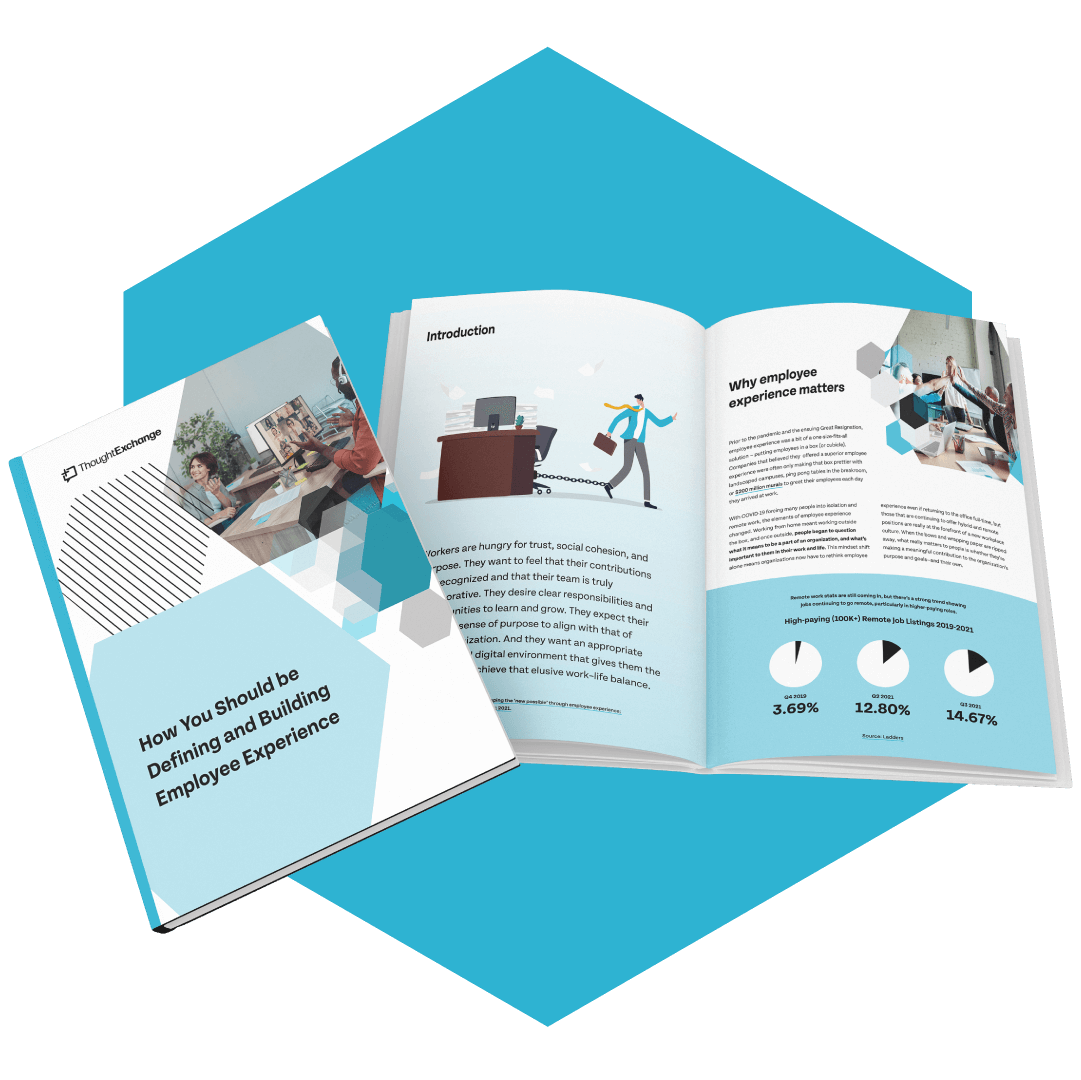May 12, 2025
Catherine Daly
How to Improve Agility in the Workplace
11 minutes
‘Workplace agility’ became one of the top buzzwords of the last few years as organizations around the world battled to remain operational amid pandemic-related disruption. But agility in the workplace is not a new phenomenon. Most software development teams have followed agile work principles for decades to create and respond to change quickly and efficiently.
In a Forbes article, Why Agile is Eating the World, Steve Denning argues that ‘agile’ is not just a software mindset. He wrote, “Firms have to be nimble, adaptable, [and] able to adjust on the fly to meet the shifting whims of a marketplace driven by the customer.” In other words, agile mindsets are required across the entire organization to succeed in modern business.
Digital transformation efforts made agility in the workplace necessary for all business units—not just development teams—and the pandemic only cemented the importance of agile workforces.
But what is agility in the workplace, why is it important, and how can managers encourage agile mindsets and build agility into the company culture? Read on to find out.
What is agility in the workplace?
According to Gallup, agility in the workplace is “employees' capacity to gather and disseminate information about changes in their environment and respond to that information quickly and expediently."
From a strategic perspective, agility in the workplace is the ability to combine speed and data-driven innovation to maintain a competitive advantage. Agility in the workplace can also generate increased productivity, higher employee engagement, and better ability to adapt to external forces such as market changes, buyer behavior, and economic conditions.
We saw wonderful examples of companies adopting agile business models during the pandemic. Some changed their entire structure to support the transition to remote work; others pivoted their business strategy to meet new market needs that arose during the pandemic.
In the public sector, schools—teachers and IT teams, in particular—demonstrated incredible agility in the workplace as they adapted to using technology to teach children remotely.
In the business-to-consumer sector, Molson Coors launched a direct-to-consumer model to assert more control over its supply chain. The brand demonstrated agility in the workplace by launching a pilot e-commerce site in just ten days, enabling local delivery in the Toronto area.
Gallup’s 10 principles of agility
Analytics and advisory company Gallup discovered the following common principles in its studies of highly agile companies:
- A unified vision across the organization
- Customer-focused and performance-oriented cultures
- Diverse talent that excels in a fast-changing environment
- Leaders and managers who are developed to coach and empower
- Dynamic teams structured and networked to focus on key priorities
- Leaders who make timely, quality decisions
- Targeted, sensible, and just-in-time communication
- Stable, highly adaptable core operating processes
- The mindset to pursue simplicity and thrive in complexity
- Technology that purposefully enhances customer and employee experiences
Why is agility in the workplace important?
An agile workplace is well-equipped to deal with all the internal and external challenges a business can face. And with the pace of change in the modern world, agility in the workplace is no longer a competitive advantage—it’s a fundamental requirement to survival.
According to Gallup, eight factors drive agility: cooperation, speed of decision making, trial tolerance, empowerment, technology adoption, simplicity, knowledge-sharing, and innovation focus.
Measuring employees’ and managers’ perceptions of how an organization performs against these factors is a clever way to get a feel for your organization's agility. Once you determine a benchmark, you can start to measure your progress against it over time.

6 organizational benefits of agility in the workplace
While there are many benefits to an agile workplace, here are the top six:
1. Faster time to market for innovation
Since 2000, 52 percent of companies in the Fortune 500 have either gone bankrupt, been acquired, or ceased to exist as a result of digital disruption. If your company plans to be around twenty years from now, speed of innovation will be key to your success.
Time to market (TTM) is the duration needed to bring a product or service to fruition. This includes generating ideas for the product or service, its design cycle, development, and launch. The more agile your company is, the faster these innovations can get to market. An agile methodology can transform the organization, prioritizing flexibility and reducing wasted time.
2. Higher profit margins
Agile mindsets prioritize the human aspect of work, boosting morale and increasing employee motivation and engagement. This translates to higher quality work and, in turn, better results for the company. A study by Korn Ferry found companies with particularly agile individuals have 25 percent higher profit margins than their less agile coworkers.
Likewise, Gallup research shows that when workers perceive their business culture to be agile, they are more likely to believe that their company is ahead of the competition, that the company's financial future is secure, and that their employer is successful and growing.

3. Greater customer satisfaction
Agility requires a more collaborative communication model than traditional business styles. This communication extends outside the organization to customers and stakeholders to ensure a recurring feedback loop regarding products and services.
Customers feel part of the team, and their feedback can help you stay informed of what matters to them and deliver the best products and services possible.

4. Greater team diversity
The Business Agility Institute interviewed and surveyed over 400 professionals, coaches, and leaders to gain insights on how agility and diversity, equality, and inclusion (DE&I) overlap. It found that DE&I and agile work practices share common values and principles, and when these values align within an organization, they improve working conditions and business outcomes. Further, diverse, empowered teams working in inclusive, equitable environments can create products that appeal to a wider range of customers.
The study also found that organizations that embed DE&I directly into their agile transformations outperform those organizations that do not.
5. More resilient businesses
Organizations able to absorb and adapt to the challenges are, by definition, resilient. Likewise, resilient employees can weather the storm, adapt to adverse situations, manage stress, and retain motivation. By challenging people to be more agile, you can improve both individual and overall organizational resilience.
6. Improved employee satisfaction
Agility in the workplace encourages short-cycle iterations that push teams to focus on fewer, more critical activities. As a result, teams identify and work on more important tasks, streamlining activities, and cutting out unnecessary tasks. This not only increases the organization's efficiency but also helps create a better employee experience.
Agility also gives employees the autonomy to work around their own schedule, increasing their satisfaction levels and preparing them to become better leaders of tomorrow. A study by Korn Ferry found executives with high levels of learning agility are five times more likely to stay highly engaged in their jobs.
Why agility in the workplace is important to employees
The benefits of having an agile and resilient workforce are unreliable—93 percent of employees that identify as resilient say they want to stay with their employer and 86 percent feel fully motivated at work.
Employees crave agility. There is no better example of this than how employees embraced remote work—with no negative impact on productivity—during the pandemic.
According to a 2021 State of Remote Work Report from Owl Labs, 90 percent of the 2,050 full-time remote workers surveyed said they were as productive or more productive working remotely, and 84 percent reported that working remotely after the pandemic would make them happier, with many even willing to take a pay cut.
While some leaders continue to ignore the phenomenon of ‘the great resignation’ and insist employees come back to the office, data scientists at The Ladders project that 25 percent of all professional jobs in North America will be remote by the end of 2022, and that remote opportunities will continue to increase through 2023.
Flexible environments promote agility in the workplace
In an agile work environment, employees don’t feel the need to practice ‘presenteeism’ (i.e. merely being seen to be at a desk from 9-5 regardless of productivity). An agile workplace promotes a more flexible schedule for workers, providing the autonomy to shake up the workday to align with the most productive times.
Some companies are implementing “work when you need to” models by measuring job KPIs such as project milestones and deliverables instead of hours logged. In this model, employees gather to collaborate and then break apart to work towards personal goals. The flexible approach to employees’ desire to do autonomous work ultimately results in increased productivity, greater enthusiasm, better employee retention, and ultimately, an enhanced employee experience.

10 methods for improving agility in the workplace
1. Increase speed and efficiency
Agility in the workplace completely depends on the speed with which employees can take action to solve problems. According to Gallup, speed is associated with employee empowerment, decentralized decision-making, and a focus on procedural simplicity.
Practice an effective decision-making process to maximize the speed of assessing a situation and increase efficiency by empowering employees to act. Experts recommend encouraging speed and productivity over perfectionism; however, leaders should consider the potential for trade-offs between speed and quality.
Create quality expectations and teach employees that being empowered to make more decisions comes with the responsibility to uphold the organization's quality standards.
2. Let people fail
A Gallup study reports only one in four employees "strongly agree" that their company creates an environment where they can try, fail, and learn from mistakes. But creating a safe space where employees can fail is essential to building agility in the workplace. If people are afraid to fail, they will be reluctant to voice their opinions or try new things.
Harvard Business School professor Amy Edmondson studied three different kinds of failures:
- Preventable failures occur when individuals fail because they didn’t follow organizational procedures or rules
- Complex failures occur due to intrinsic conditions or risk of an occupation or task and may involve mistakes by one or many people
- Intelligent failures occur due to experimentation and innovation
Amy found that complex and intelligent failures to have great potential to promote learning in the workplace. Conversely, when complex or intelligent failures are buried or left undiscussed, others risk repeating the same mistakes. The result? Increasingly inefficient organizations that replicate, instead of learning from, mistakes.
3. Tap into employee innovation
Agile organizations understand the importance of tapping into an employee’s resourcefulness to solve problems and generate innovative new ideas. By offering employees the freedom and resources to experiment without facing criticism in an agile environment, employees will feel safe while expressing their thoughts and ideas.
According to Gallup, many organizations do a better job of encouraging employees to share and discuss new ideas than they do of creating an environment where they are empowered to try them out. Leaders must understand that for most large firms, experimentation can no longer be a prerogative of R&D teams only.

4. Listen to employees
Agility in the workplace requires a regular communications cadence with employees. Instead of an annual employee feedback survey, develop a management culture that encourages small and frequent interactions with staff, focusing on what the organization needs today and getting feedback immediately. If it takes weeks to get the results of a survey, it’s just not timely enough to be useful.
Listening is only half the battle. It is important that you act on what you hear. Explorance’s 2021 Employee Feedback Survey found that nearly half of employees and 40 percent of executives do not believe their feedback leads to meaningful change.
Read Listening to Employees: Getting it Right for tips on the best way to communicate with and gather feedback from employees in an agile workplace.
5. Build a culture of collaboration and knowledge-sharing
Some companies encourage a collaborative environment that enables agility; most don't. According to a Gallup study, only 30 percent of U.S. and 36 percent of European workers strongly agree that their coworkers share knowledge. But without collaboration and knowledge sharing about customers' needs, agile teams operate less effectively.
Organizations struggling to build a collaborative culture may need some quick ways to make a difference. For example, in a scenario where group members feel uneasy presenting ideas in a brainstorming session, leaders can suggest taking the brainstorm online using an engagement tool like ThoughtExchange to give teams a voice on prominent issues efficiently and effectively. With a well-formulated open-ended question, leaders can use ThoughtExchange to solicit feedback from their teams—whether employees are office-based or at home—on issues that benefit from collective decision-making. In doing so, leaders convey respect and interest in their employees’ thoughts and creative solutions.
6. Increase employee engagement
HR publication Raconteur states that human resources leaders who bring together employee engagement, performance, and learning are best placed on developing agile and people-driven strategies to get the most from their workforce. That’s because engaged employees are naturally more flexible and open to new ideas.
According to Harvard Business Review, organizations with high levels of employee engagement have double the success rate of organizations with less engaged employees. That’s because when employees are engaged, they are more likely to work harder and deliver higher quality work than disengaged employees who only do the bare minimum.
Read this Quick-Start Guide to Employee Engagement for a deeper dive on this topic.
7. Encourage collective decision-making
Collective decision-making—also known as group decision-making or collaborative decision-making—occurs when a group makes a decision, and it is no longer attributable to any single individual.
There is much to be gained from a collective approach to decision-making—especially in an agile work environment. Collective decision-making is also one of the most successful ways to generate buy-in from stakeholders, build consensus, and encourage innovation and creativity in the workplace.
8. Ensure you have the right people
Agility is a key skill for professional success. Some managers mistake agility for generalization and favor general all-around skills over specialized skills during the candidate selection process. But an agile worker is not someone who can perform every task under the sun.
You’ll always perform better when you have a blend of generalists and specialists on your team. Instead of weighting your team one way or the other, vet your people to ensure they are open to adopting an agile mindset (i.e., they are willing to learn, change, and grow).
Agility simply means a worker can change when the needs of their organization or market change.
9. Develop humble leaders
Effective leaders have the confidence to move forward even when challenges arise or when there is uncertainty in their environment. They also have the humility to recognize and acknowledge when they’re wrong.
For many leaders, this is a big ask. Psychologically, leaders value a sense of control over their environment. Agile businesses need leaders who resist that tendency and embrace the fact they often do not know the answer. Luckily, there are some tools that can help leaders develop this humility. ThoughtExchange, for example, can provide leaders with the most realistic perspective on their business. It applies collective intelligence and patented anti-bias technology to engage an entire team and help leaders to see the wood from the trees.
10. Embrace a test-and-learn approach
Digital transformation and agility go hand-in-hand. An agile business is better positioned to adopt new digital technologies. Taking an agile approach to transformation means setting a goal—but not the time or cost—and adopting a test-and-learn approach.
The project is broken down into ‘sprints’ or phases, each with an individual goal. There is then time to make adjustments to achieve the desired impact.
Getting started on your path to agility in the workplace
Adopting an agile workplace requires a delicate alignment of people, digital transformation, and business goals. Organizational change—and perhaps even transformational change—needs to occur to facilitate agility in the workplace. This means you may need to change your processes, technology, department structures, and culture.
This type of change takes time. But there are some actions you can take to speed it up, the most important of which is to involve individuals in the process of adopting an agile work environment.
Using an enterprise discussion management tool like ThoughtExchange is invaluable when introducing any new change or culture shift. By creating an Exchange, you can ask an open-ended question or provide some context for the change initiative. Participants can anonymously share their answers and objectively rate each other’s responses and ideas.
If you are looking to develop a more agile work environment, ThoughtExchange can help you get buy-in from your teams.



